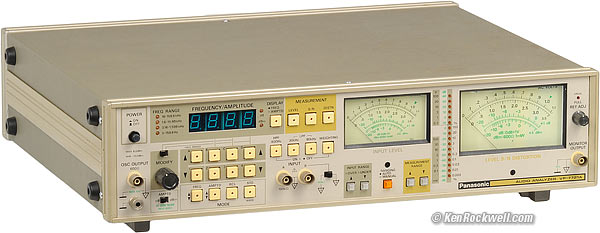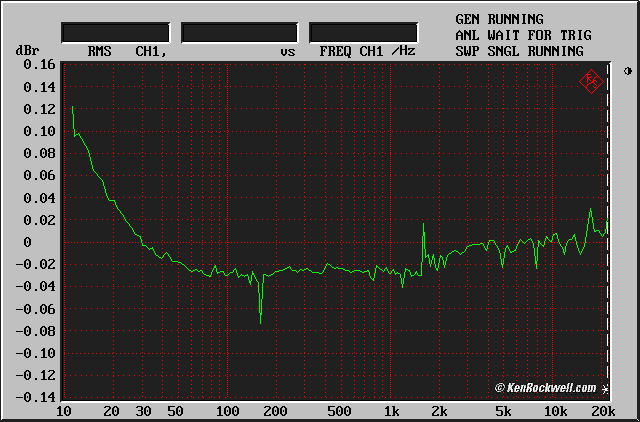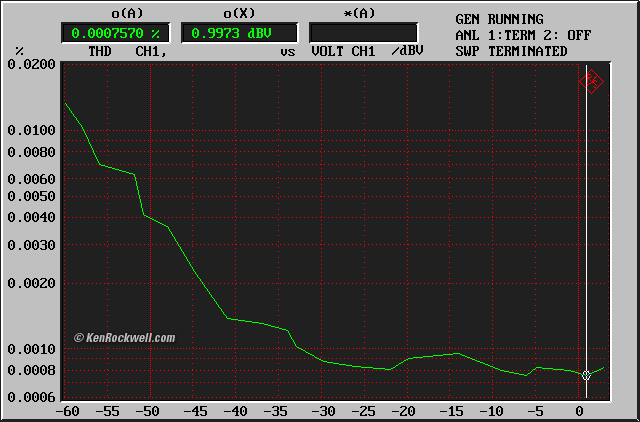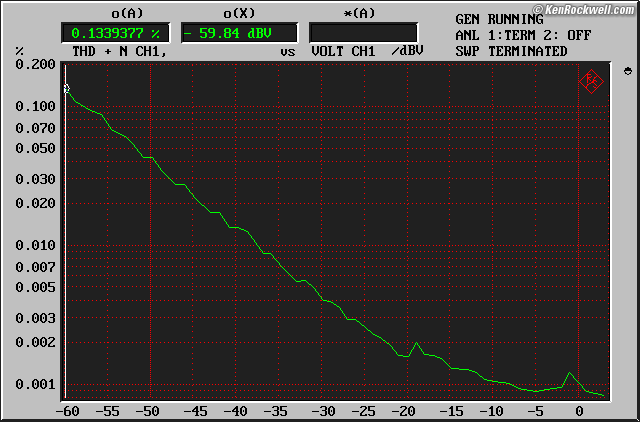Home Donate New Search Gallery Reviews How-To Books Links Workshops About Contact
Panasonic VP-7721A
Audio Analyzer and Generator
5 Hz - 160 kHz, 0.001% THD (c. 1980)
© 2011 KenRockwell.com. All rights reserved.
Intro Specs Performance Compared Usage Recommendations
Panasonic VP-7721A Audio Analyzer. enlarge. This free website's biggest source of support is when you use these links, especially this link directly to audio analyzers at eBay (see How to Win at eBay) when you get anything, regardless of the country in which you live. Thanks! Ken.
May 2011 All Reviews Audio Reviews
See also Panasonic VP-7721A Users Manual with specifications and schematics.
WARNING: This is a professional laboratory instrument. If you lack the appropriate professional qualifications, do not touch or use this device. Not only might it kill you, it is unlikely that you will be able to make any meaningful measurements without thorough knowledge and experience in electronic laboratory techniques.
Rear, Panasonic VP-7721A Audio Analyzer. enlarge.
Front, Panasonic VP-7721A Audio Analyzer. enlarge.
Introduction top
Intro Specs Performance Compared Usage Recommendations
|
I use Adorama, Amazon, Ritz, B&H, Calumet, J&R and ScanCafe. I can't vouch for ads below.
|
The Panasonic VP-7721A Audio Analyzer (a.k.a. National or Matsushita) is a high-performance laboratory THD + N, noise and level analyzer and sine-wave generator. As of 2011, they sell for about $400 used over eBay, where they appear about once a month.
It is extremely fast and easy to use. It even has a rotary setting knob with an adjustment range switch that makes manual sweeps, and fast and precise level and frequency adjustments, easy to do by feel. The knob has no stops, so you can sweep through the entire range of the instrument continuously and with great precision and speed.
It's as if someone who really knew audio designed this analyzer. It doesn't measure many things, but it measures exactly what we need in the most straightforward and precise way.
Everything is analog and auto-ranging. It works great.
The digital LED display shows the settings of the analog generator.
The small meter reads the input level.
The Christmas-tree LED display between the two meters shows the range each is reading.
The large meter displays the measurement in true RMS, while the MONITOR output near it duplicates the AC signal it is reading.
The meters have no lights, even though the LEDs obviously light in the dark.
The VP-7721A is smaller (100mm/4" tall) and lighter (10 kg/22 pounds) than similar analyzers. It has a smart carry handle, bottom feet and a rear cord rack.
It only draws 30 VA of power, so it runs so cool that no fan is needed. There are no ventilation holes needed either, meaning that the insides stay dust-free forever!
All Analog!
Even though it has a digital readout, microprocessor control, remote control and store-and-recall ability, it is a 100% analog system.
The all-analog generators, analyzers and filters are controlled via numerous reed relays driven by DC signals from the internal microcomputer. The only thing the digital sections do is set these relays, and then the digital sections and microprocessors shut off immediately and automatically to eliminate noise!
Even the LED readouts are fed from DC, not multiplexed waveforms.
The LEDs read the level and frequency settings sent to the analog generator; the LEDs are not measurements.
Thus we have a unique all-analog generator and analyzer with extreme analog performance and digital convenience.
Measurements
The VP-7721A measures levels in true RMS from 100 Volts (+40 dBV) down to 100 microvolts (-90 dBV) full scale.
Signal-to-noise ratio is automated by measuring and holding the signal level on one meter, then the generator automatically mutes after 1.5 seconds and the second autoranging meter measures the remaining noise. The difference between the two readings is the signal-to-noise ratio.
THD + Noise is measured to 0.003% (-90 dB) full scale. It's marked "THD," but it's really measuring THD + Noise. It notches the fundamental and measures what's left in true RMS with a 700 kHz bandwidth.
THD measurements are automatically tuned to the generator's setting, and the reference level is automatically set to the measured input level, even as the input level varies.
Since the analyzer auto-tunes to the generator internally, if you use an external generator or test signal, tune the generator to the same frequency as the test signal to tune the distortion analyzer. Adjust the frequency slightly if needed for the lowest distortion reading; if I'm within a couple of percent of frequency I'm fine.
400 Hz high-pass and 30 kHz and 80 kHz low-pass filters each have their own buttons. The weighting button is for optional filters.
Generator Output
Digitally controlled, the analog generator can be swept in frequency without burping or missing a beat. If you change the level, sometimes there are slight clicks as different attenuator ranges are kicked-in.
The generator always runs at the same regulated level internally. The output level is varied with a 600 Ω precision resistive attenuator, controlled by the microcontroller.
The output floats from the chassis ground.
Its range is from +4 dBv to -75.9 dBV, when terminated with 600 Ω.
The generator is calibrated expecting a 600 Ω load, so if you don't terminate it, know that the levels will be twice the voltage (6 dB greater) than the indicated values.
Analyzer Inputs
A and B inputs are 100 kΩ shunted by 150 pF maximum, each input.
For most use, use the unbalanced A input, and set the B input ground switch to the right, disabling the B input.
For balanced, floating use, use the B input along with the A input, and move the ground switch to the left 100 kΩ position. Now the reading is differential across A and B, ignoring the grounds. Use this position for bridged power amplifiers.
All the signal grounds are floated from the chassis to various degrees, read the manual for explicit details.
Analyzer Outputs
In addition to the two analog meters, there is a front panel MONITOR output, and a rear panel DC OUTPUT.
MONITOR output
The MONITOR output is the same as the signal fed to the RMS converter and then read on the large meter. It's about 1 V RMS at full scale from 1 kΩ.
Feed the MONITOR output to an amp and speaker to hear what's going on, or to an oscilloscope or FFT analyzer for further analysis.
During LEVEL and S/N measurements, it's the same as the input signal, amplified, attenuated and filtered (400 Hz, 30 kHz or 80 kHz) as selected. At the lower input levels, this also lets the VP-7221A be used as a precision preamplifier.
During DISTORTION readings, it's the distortion and noise left after the notch and and filters as selected.
DC output (rear panel)
The DC output follows the large meter. Poke it into a DVM and set your calibration accordingly if you want digital readouts.
Full scale reads about 1 VDC.
Specifications top
Intro Specs Performance Compared Usage Recommendations
In addition to the above specifications, residual THD + N for the combined analyzer and generator is rated at -95 dB (0.0017%) for most conditions.
Generator frequency accuracy is rated about ±2%, level accuracy is rated at about ±0.5 dB (5%) and flatness is rated about ±0.1 dB (1%).
Voltmeter accuracy is rated about ±3% full-scale and flatness is rated about ±0.5 dB (5%).
See the manual for all the details.
Measured Performance top
Intro Specs Performance Compared Usage Recommendations
As expected for laboratory equipment, it performs much better than specified.
Measurement bandwidth is 700 kHz (-3 dB).
It feels great; it's so much easier to make measurements and real-time adjustments with analog needles than blinking LEDs.
There's no needle wiggle at 5 Hz, either!
Generator Flatness top
1 Volt RMS, measured with a Rohde & Schwarz UPL, 600Ω input, 22 kHz bandwidth:
Genrator flatness, 10 Hz - 22kHz. bigger.
Inherant Flatness top
Measured from generator to the VP-7721A's own meter, generator set to +4.0 dBV, single BNC cable to non-floating A input, not terminated except for 100 kΩ/150pF max, so actual level should be +10 dBV (3.1623 V).
For the sake of sanity, I subtracted 10 dB from the analyzer's readings to normalize them to 0 dB.
Set Frequency |
INPUT LEVEL (small averaging meter) reads |
LEVEL S/N DISTORTION (large RMS meter) reads |
Actual Level* |
Actual Level* |
4 Hz*** |
+0.1 dB |
-0.5 dB |
- |
- |
5 Hz |
+0.1 dB |
-0.33 dB |
10.03 dBV |
3.172-3.1812 V |
10 Hz |
+0.1 dB |
0.0 dB |
10.02 dBV |
3.1720 V |
20 Hz |
+0.05 dB |
+0.1 dB |
9.99 dBV |
3.1586 V |
50 Hz |
+0.05 dB |
+0.12 dB |
9.96 dBV |
3.1507 V |
100 Hz |
+0.02 dB |
+0.15 dB |
9.96 dBV |
3.1495 V |
200 Hz |
+0.05 dB |
+0.1 dB |
9.97 dBV |
3.1515 V |
500 Hz |
+0.02 dB |
+0.1 dB |
9.97 dBV |
3.1525 V |
1 kHz |
+0.05 dB |
+0.1 dB |
9.98 dBV |
3.1543 V |
2 kHz |
+0.05 dB |
+0.05 dB |
9.99 dBV |
3.1585 V |
5 kHz |
+0.05 dB |
+0.05 dB |
9.98 dBV |
3.1567 V |
10 kHz |
+0.05 dB |
+0.05 dB |
9.99 dBv |
3.1574 V |
20 kHz |
+0.05 dB |
+0.05 dB |
9.99 dBV |
3.1574 V |
50 kHz |
+0.05 dB |
0.0 dB |
-28.68 dBV** |
36.66 mV** |
100 kHz |
+0.05 dB |
-0.05 dB |
-38.97 dBV** |
9 mV** |
159.9 kHz |
-0.02 dB |
-0.15 dB |
-43 dBV** |
16.4 mV ** |
200 kHz*** |
-0.2 dB |
-0.2 dB |
- |
- |
500 kHz*** |
-0.5 dB |
-0.7 dB |
- |
- |
700 kHz*** |
-0.7 dB |
-3 dB |
- |
- |
1 MHz*** |
-1.2 dB |
-16 dB |
- |
- |
2 MHz*** |
-3.5 dB |
->20dB |
- |
- |
* measured with a Tektronix TX3.
** Tektronix TX3 bandwidth is only 20 kHz.
*** Fed from an external HP 209A oscillator.
To match my Tektronix TX3 at 10 V RMS at 1 kHz, multiply the voltage reading of the VP-7721A's voltmeter by 0.9783.
As we can see, the -3 dB bandwidth of the system as read by the RMS-calibrated, average-responding level meter is about 2 MHz, while the RMS detector driving the large measurements meter has a 700 kHz bandwidth, and a slightly reduced (-0.4 dB at 5 Hz) ultralow frequency response.
THD versus Level, 1 kHz top
Measured with a Rohde & Schwarz UPL, 600Ω input, 22 kHz bandwidth:
THD versus level, dBV, 1 kHz. bigger.
Distortion Harmonics, 1 kHz, +4 dBV top
Measured with a Rohde & Schwarz UPL, 600Ω input, 22 kHz bandwidth:
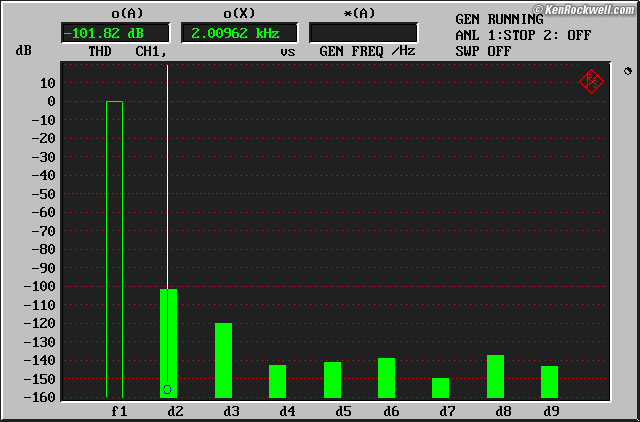
THD, +4 dBV, 1 kHz.
THD+N versus Level, 1 kHz top
Measured with a Rohde & Schwarz UPL, 600Ω input, 22 kHz bandwidth:
THD+N versus level, dBV, 1 kHz. bigger.
Residual THD + Noise top
Generator set to +4 dBV, one BNC cable to non-floating A input, unterminated (which means the output is +10 dBV), 3V input range:
30 kHz BW* |
80 kHz BW* |
Full BW |
|
5 Hz |
0.0019% / -94.4 dB |
0.0019% / -94.4 dB |
0.0021% / -93.6 dB |
10 Hz** |
0.013% / -77.7 dB |
0.013% / -77.7 dB |
0.013% / -77.7 dB |
20 Hz |
0.0006% / -104.4 dB |
0.0007% / -103.1 dB |
0.00115% / -98.8 dB |
50 Hz |
0.0008% / -101.9 dB |
0.0008% / -101.9 dB |
0.0012% / -98.4 dB |
100 Hz |
0.0006% / -104.4 dB |
0.00065% / -103.7 dB |
0.0011% / -99.2 dB |
200 Hz |
0.0006% / -104.4 dB |
0.0006% / -104.4 dB |
0.0011% / -99.2 dB |
440 Hz |
0.0004% / -108.0 dB |
0.00045% / -107.0 dB |
0.001% / -100 dB |
500 Hz |
0.00047% / -106.6 dB |
0.0005% / -106.0 dB |
0.001% / -100 dB |
1 kHz |
0.00045% / -107.0 dB |
0.0005% / -106.0 dB |
0.001% / -100 dB |
2 kHz |
0.0007% / -103.1 dB |
0.00075% / -102.5 dB |
0.0012% / -98.4 dB |
5 kHz |
0.0005% / -106.0 dB |
0.0006% / -104.4 dB |
0.0011% / -99.2 dB |
10 kHz |
0.0005% / -106.0 dB |
0.0006% / -104.4 dB |
0.0011% / -99.2 dB |
20 kHz** |
0.0014% / -97.1 dB |
0.0032% / -89.9 dB |
0.0035% / -89.1 dB |
50 kHz |
0.00035% / -109.1 dB |
0.0008% / -101.9 dB |
0.0025% / -92.0 dB |
100 kHz |
0.00028% / -111.1 dB |
0.0006% / -104.4 dB |
0.003% / -90.5 dB |
159.9 kHz |
0.00028% / -111.1 dB |
0.0009% / -100.9 dB |
0.013% / -77.7 dB |
* THD + N doesn't really count above 20 kHz with the measurement bandwidth set to 80 kHz, or above 7.5 kHz with the filter set to 30 kHz.
** THD + N really is worse at 7-12 Hz and 18-22 kHz for some reason.
Frequency Accuracy top
As this is an all-analog generator, there is no quartz-crystal control. The frequencies are dependant on very tight-tolerance analog components.
As measured with a Tektronix TX3:
Set Frequency |
Actual Frequency |
Error |
5 Hz |
4.97 Hz |
-0.6% |
10 Hz |
9.94 Hz |
-0.6% |
20 Hz |
19.84 Hz |
-0.8% |
50 Hz |
49.58 Hz |
-0.84% |
100 Hz |
99.14 Hz |
-0.86% |
200 Hz |
200.7 Hz |
+0.35% |
500 Hz |
501.3 Hz |
+0.26% |
1 kHz |
1.002 kHz |
+0.2% |
2 kHz |
2.000 kHz |
±0.0% |
5 kHz |
4.997 kHz |
-0.06% |
10 kHz |
9.989 kHz |
-0.11% |
20 kHz |
20.14 kHz |
+0.7% |
22 kHz |
22.12 kHz |
+0.55% |
25 kHz |
25.14 kHz |
+0.56% |
30 kHz |
30.23 kHz |
+0.77% |
50 kHz |
50.35 kHz |
+0.77% |
100 kHz |
100.5 kHz |
+0.5% |
159.9 kHz |
160.2 kHz |
+0.19% |
It's well within ± 0.9%, which is great considering the specification is ±2% to ±3% depending on range.
Compared top
Intro Specs Performance Compared Usage Recommendations
The HP 8903 is the most likely comparison. This VP-7721A has a much broader frequency range, more sensitive low-level input, lower actual system distortion floor, much easier and faster manual use with its rotary input knob for frequency and level setting. The HP 8903 is bigger, heavier, noisier and more expensive, but it does measure input frequency very precisely, while this VP-7721A doesn't measure it at all.
The HP 8903 is digital; the VP-7721A uses 100% analog measurement and generator circuitry. Digital displays are awful for adjusting equipment to nulls, or for analyzing sweeps visually.
Older analog analyzers are a pain, as they require a lot of fiddling to null.
Newer all-digital analyzers like AP can measure a lot more things we don't need, but most require an additional outboard PC and have cooling fans that make noise and pull dirt into the units. They also take much longer to set up and use. They're great for printing fancy curves, while the VP-7721A is much better for realtime use on a bench.
Sound cards and computer software are cheap, but don't have the native-analog ultra low-distortion generation and analysis abilities of this all-analog VP-7721A.
Usage top
Intro Specs Performance Compared Usage Recommendations
See also the Panasonic VP-7721A Users Manual with specifications and schematics.
Recommendations top
Intro Specs Performance Compared Usage Recommendations
This is a marvelous instrument for use on a bench for design and analysis. Its performance irs probably the highest of any all-analog analyzer and generator.
It's also the only digitally-controlled generator that has a clever enough control circuit (a rotary knob) that actually allows useful manual sweeping for finding loudspeaker resonances and doing the things that usually require a traditional analog generator.
It's not an automated digital rig for use in production or automatic testing.
Help me help you top
I support my growing family through this website, as crazy as it might seem.
The biggest help is when you use any of these links to Adorama, Amazon, eBay, B&H, Ritz, Calumet, J&R and ScanCafe when you get anything, regardless of the country in which you live. It costs you nothing, and is this site's, and thus my family's, biggest source of support. These places have the best prices and service, which is why I've used them since before this website existed. I recommend them all personally.
If you find this page as helpful as a book you might have had to buy or a workshop you may have had to take, feel free to help me continue helping everyone.
If you've gotten your gear through one of my links or helped otherwise, you're family. It's great people like you who allow me to keep adding to this site full-time. Thanks!
If you haven't helped yet, please do, and consider helping me with a gift of $5.00.
As this page is copyrighted and formally registered, it is unlawful to make copies, especially in the form of printouts for personal use. If you wish to make a printout for personal use, you are granted one-time permission only if you PayPal me $5.00 per printout or part thereof. Thank you!
Thanks for reading!
Mr. & Mrs. Ken Rockwell, Ryan and Katie.
Home Donate New Search Gallery Reviews How-To Books Links Workshops About Contact

